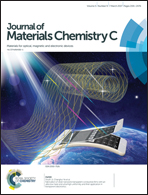Water-free synthesis of ZnO quantum dots for application as an electron injection layer in light-emitting electrochemical cells
Abstract
Large-area light emitters like organic (OLEDs) or quantum dot light-emitting devices (QLEDs) and light-emitting electrochemical cells (LECs) have gained increasing interest due to their cost-effective fabrication on various even flexible substrates. The implementation of ZnO nanoparticles as an electron injection layer in large-area emitters leads to efficient solution-based devices. However, ZnO support layers are frequently in direct contact with water-sensitive emitter materials, which requires ZnO nanoparticles with minimum water content. A water-free synthesis route (except for the small amount of water formed during the synthesis) of ligand-free ZnO nanoparticles is presented. The spherical ZnO nanoparticles have a diameter of 3.4 nm, possess a high crystallinity, and form stable dispersions in ethanol or 1-hexanol. Their application together with a transition metal complex (iTMC)-LEC as an additional electron injection layer resulted in an increase of the device efficiency from 1.6 to 2.4 lm W−1 as well as the reduction of the run-up time to one fifth, compared to the same system without ZnO nanoparticles.



 Please wait while we load your content...
Please wait while we load your content...